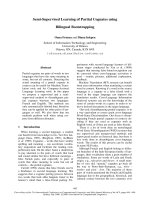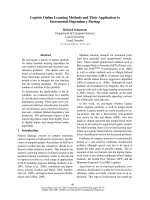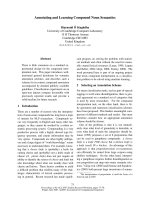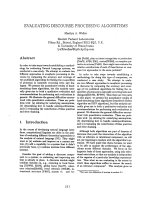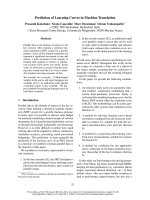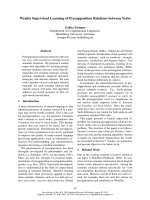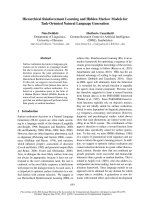Báo cáo khoa học: "Graph-based Semi-Supervised Learning Algorithms for NLP" potx
Bạn đang xem bản rút gọn của tài liệu. Xem và tải ngay bản đầy đủ của tài liệu tại đây (66.86 KB, 1 trang )
Tutorial Abstracts of ACL 2012, page 6,
Jeju, Republic of Korea, 8 July 2012.
c
2012 Association for Computational Linguistics
Graph-based Semi-Supervised Learning Algorithms for NLP
Amar Subramanya
Google Research
Partha Pratim Talukdar
Carnegie Mellon University
Abstract
While labeled data is expensive to prepare, ever in-
creasing amounts of unlabeled linguistic data are
becoming widely available. In order to adapt to
this phenomenon, several semi-supervised learning
(SSL) algorithms, which learn from labeled as well
as unlabeled data, have been developed. In a sep-
arate line of work, researchers have started to real-
ize that graphs provide a natural way to represent
data in a variety of domains. Graph-based SSL al-
gorithms, which bring together these two lines of
work, have been shown to outperform the state-of-
the-art in many applications in speech processing,
computer vision and NLP. In particular, recent NLP
research has successfully used graph-based SSL al-
gorithms for PoS tagging (Subramanya et al., 2010),
semantic parsing (Das and Smith, 2011), knowledge
acquisition (Talukdar et al., 2008), sentiment anal-
ysis (Goldberg and Zhu, 2006) and text categoriza-
tion (Subramanya and Bilmes, 2008).
Recognizing this promising and emerging area of re-
search, this tutorial focuses on graph-based SSL al-
gorithms (e.g., label propagation methods). The tu-
torial is intended to be a sequel to the ACL 2008
SSL tutorial, focusing exclusively on graph-based
SSL methods and recent advances in this area, which
were beyond the scope of the previous tutorial.
The tutorial is divided in two parts. In the first
part, we will motivate the need for graph-based SSL
methods, introduce some standard graph-based SSL
algorithms, and discuss connections between these
approaches. We will also discuss how linguistic data
can be encoded as graphs and show how graph-based
algorithms can be scaled to large amounts of data
(e.g., web-scale data).
Part 2 of the tutorial will focus on how graph-based
methods can be used to solve several critical NLP
tasks, including basic problems such as PoS tagging,
semantic parsing, and more downstream tasks such
as text categorization, information acquisition, and
sentiment analysis. We will conclude the tutorial
with some exciting avenues for future work.
Familiarity with semi-supervised learning and
graph-based methods will not be assumed, and the
necessary background will be provided. Examples
from NLP tasks will be used throughout the tutorial
to convey the necessary concepts. At the end of this
tutorial, the attendee will walk away with the follow-
ing:
• An in-depth knowledge of the current state-of-
the-art in graph-based SSL algorithms, and the
ability to implement them.
• The ability to decide on the suitability of
graph-based SSL methods for a problem.
• Familiarity with different NLP tasks where
graph-based SSL methods have been success-
fully applied.
In addition to the above goals, we hope that this tu-
torial will better prepare the attendee to conduct ex-
citing research at the intersection of NLP and other
emerging areas with natural graph-structured data
(e.g., Computation Social Science).
Please visit for details.
References
Dipanjan Das and Noah A. Smith. 2011. Semi-supervised
frame-semantic parsing for unknown predicates. In Proceed-
ings of the ACL: Human Language Technologies.
Andrew B. Goldberg and Xiaojin Zhu. 2006. Seeing stars when
there aren’t many stars: graph-based semi-supervised learn-
ing for sentiment categorization. In Proceedings of the Work-
shop on Graph Based Methods for NLP.
Amarnag Subramanya and Jeff Bilmes. 2008. Soft-supervised
text classification. In EMNLP.
Amarnag Subramanya, Slav Petrov, and Fernando Pereira.
2010. Graph-based semi-supervised learning of structured
tagging models. In EMNLP.
Partha Pratim Talukdar, Joseph Reisinger, Marius Pasca,
Deepak Ravichandran, Rahul Bhagat, and Fernando Pereira.
2008. Weakly supervised acquisition of labeled class in-
stances using graph random walks. In EMNLP.
6

